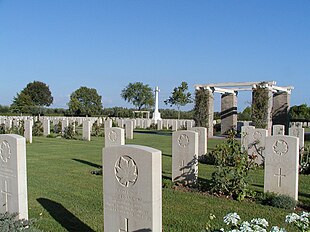Winter Line: Difference between revisions
m Interwiki |
mNo edit summary |
||
| Line 31: | Line 31: | ||
*[http://www.military.com/Resources/ResourceFileView?file=worldwarii_europe_maps_map47.htm Map of German defensive lines] |
*[http://www.military.com/Resources/ResourceFileView?file=worldwarii_europe_maps_map47.htm Map of German defensive lines] |
||
*[http://www.wwii.ca/page30.html The Liri Valley: Canada’s Breakthrough to Rome] |
*[http://www.wwii.ca/page30.html The Liri Valley: Canada’s Breakthrough to Rome] |
||
===Multimedia=== |
|||
*[http://archives.cbc.ca/war_conflict/second_world_war/clip/9859/ CBC Archives] CBC Radio reports from the Winter Line on May 14, 1944. |
|||
[[Category:World War II defensive lines]] |
[[Category:World War II defensive lines]] |
||
Revision as of 07:02, 24 March 2008

The Winter Line was a series of German military fortifications in Italy, constructed during World War II by Organisation Todt. The main line of fortification, called the Gustav Line, ran across Italy from just north of where the Garigliano River flows into the Tyrrhenian Sea in the west, through the Apennine Mountains to the mouth of the Sangro River on the Adriatic Sea in the east. The center of the line, where it crossed the main route north to Rome (Highway 6) which followed the Liri valley, was anchored around the mountains behind the town of Cassino including Monte Cassino, which had an old abbey sitting atop it and which dominated the entrance to the Liri valley, and Monte Cairo which gave the defenders clear observation of any potential attackers. On the western side of the Apennines there were two subsidiary lines: the Bernhardt Line in front of the main Gustav positions and the Hitler Line some 5 miles to the rear. The Winter line was fortified with gun pits, concrete bunkers, turreted machine-gun emplacements, barbed-wire and minefields. It was the strongest of the German defensive lines south of Rome. About 15 German divisions were employed in the defence. It took the Allies from mid-November 1943 to late May 1944 to fight through all the various elements of the Winter Line.
Various published sources use differing definitions of the Winter Line and its components. The above represents a best-efforts consensus.
Accounts of the fighting in late 1943 and the first half of 1944 on the various parts of the Winter Line appear in the articles shown when the The Winter Line and the battle for Rome campaignbox on the right of this article is expanded.
Bibliography

- Unknown (1945). CMH Online bookshelves: Fifth Army at the Winter Line 15 November 1943 - 15 January 1944. Washington: US Army Center of Military History. CMH Pub 100-9.
{{cite book}}: External link in|title= - Unknown (1944). CMH Online bookshelves: From the Volturno to the Winter Line 6 October-15 November 1943. Washington: US Army Center of Military History. CMH Pub 100-8.
{{cite book}}: External link in|title= - Col. Kenneth V. Smith (1944). CMH Online bookshelves: WWII Campaigns, Naples-Foggia 9 September 1943-21 January 1944. Washington: US Army Center of Military History. CMH Pub 72-17.
{{cite book}}: External link in|title= - Gerhard Muhm : German Tactics in the Italian Campaign , http://www.larchivio.org/xoom/gerhardmuhm2.htm
- Gerhard Muhm : La Tattica tedesca nella Campagna d'Italia, in Linea Gotica avanposto dei Balcani, (Hrsg.) Amedeo Montemaggi - Edizioni Civitas, Roma 1993
- Field Marshall Lord Carver (2001). The Imperial War Museum Book of the War in Italy 1943-1945. London: Sidgwick & Jackson. ISBN 0 330 48230 0.
See also
- Operation Shingle
- Battle of Monte Cassino
- Battle of San Pietro Infine
- Barbara Line
- Brazilian Expeditionary Force
- Bernhardt Line
- European Theatre of World War II
- Italian Campaign (World War II)
External links
Multimedia
- CBC Archives CBC Radio reports from the Winter Line on May 14, 1944.
